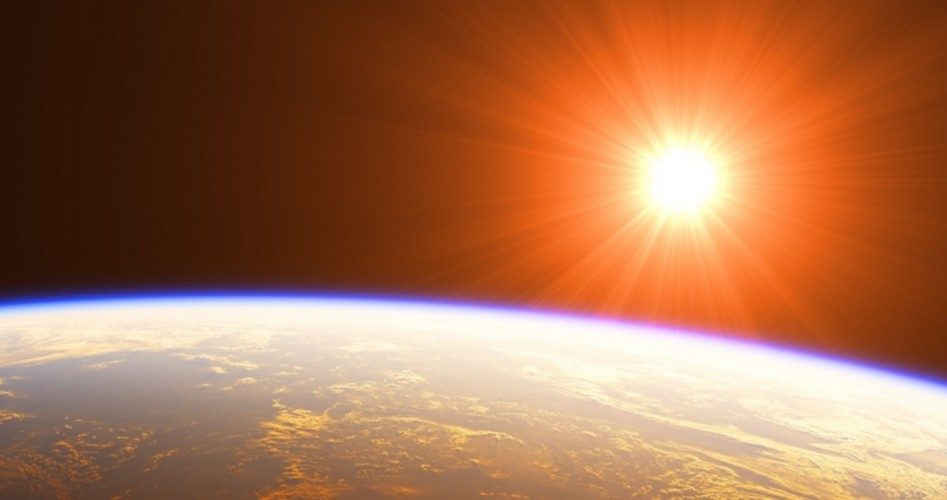
For the first time in over 10 years, a month has passed with no sunspot activity. In February of 2019, not one sunspot was recorded. Not since August of 2008, when the Sun was going through a time of Solar Minimum, has a month gone without a sunspot.
So, while some climatologists are concerned about carbon atoms covalently bonded with pairs of oxygen atoms (carbon dioxide) down here on Earth, and blaming an increase in that tiny portion (0.04 percent) of our atmosphere for everything from Brexit to brain-eating amoebas, something is going on with that big ball of light in the sky that provides the Earth with warmth and light.
But don’t be too alarmed. Solar Minimum is a part of the Sun’s natural cycle. Every 11 years, sunspot activity drops to near zero, and those dark cores, which produce solar flares and coronal mass ejections, seemingly vanish. The last such minimum in 2008 was surprising to longtime observers as sunspot activity dropped to a 100-year low as the Sun dimmed by 0.1 percent.
As Ed Hiserodt points out in the March 4 edition of The New American, “Every 11 years, the polarity of the Sun reverses, and the Sun goes through a cycle of increasing and decreasing sunspot activity, solar flares, and solar radiation.”
But some Solar Minimums are more extreme than others and may affect the climate far more than a trace greenhouse gas ever could. Consider the Maunder Minimum, which occurred in the late 17th to early 18th century. This minimum coincided with a prolonged period of cooler than usual temperature known as the Little Ice Age.
And some scientists are predicting a new “Grand Solar Minimum” in coming decades. Dr. Dan Lubin and his team at UC-San Diego published a study in late 2017 indicating that our Sun may go through a grand solar minimum in the coming decades that could be even worse than the Maunder Minimum.
Likewise, at Northumbria University in Great Britain, Dr. Valentina Zharkova and her team released a paper in 2017 suggesting that sunspot activity might fall by as much as 60 percent during the 2030s.
It’s important to note that neither Lubin’s or Zharkova’s team — or their studies — are predicting a coming Little Ice Age. Lubin, in fact, has said that “an upcoming (solar) event would not stop the current trend of planetary warming but might slow it somewhat.”
And Zharkova has also stopped short of claiming an end of global warming, perhaps only a pause in it. “I hope global warming will be overridden by this effect, giving humankind and the Earth thirty years to sort out our pollution.”
And, to be fair, the Little Ice Age may have been not only solar-related. Massive volcanic eruptions, such as the 1680 eruption of Krakatoa, seemed to have played a part in the cooling of those centuries as well. Those volcanoes have always erupted; and they will again.
But it’s still extremely interesting that the last real cooling phase that the Earth has gone through, the Little Ice Age, coincided with the grand solar minimum known as the Maunder Minimum. And at least two studies by major research groups are predicting similar solar conditions in the coming decades.
Which brings us back to today and the utter absence of sunspot activity in February. The last Solar Minima in 2008-2009 taught us a few things. For instance, the last minima produced a collapse of the Earth’s thermosphere, which NASA tells us may be happening again. Also, solar winds fell to unprecedented levels, while cosmic rays, which are normally repelled by the solar winds surged. It is speculated by some scientists that cosmic rays may, in effect, seed clouds in Earth’s atmosphere. And we know that clouds definitely impact the climate.
Meanwhile, here on Earth, politicians are telling us we need a “Green New Deal” in order to address our supposed addiction to fossil fuels and the damage we’re doing to the environment by exhaling CO2 when we breathe. Honestly, it’s like ants arguing over which kind of dirt they can and can’t use as they build their colony, never even thinking about the giant foot (the Sun) that could crush their hill at any time.
Photo: 3DSculptor/iStock/Getty Images Plus




